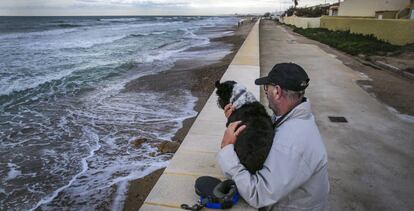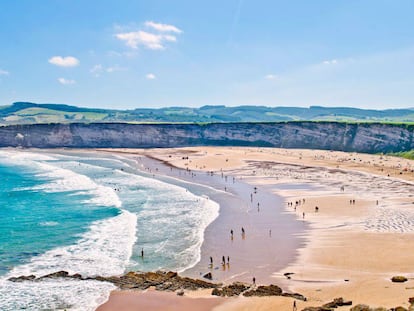The disappearing sands of Valencia¡¯s beaches
Rising sea levels have eaten away 50 meters of shoreline to the south of the city since 1984

The beaches south of the city of Valencia, some of them within the protected Albufera Natural Park, home to the large fresh water lagoon of the same name, are fast being eroded, with the shoreline diminishing by some 50 meters since 1984, and sparking concern over the repercussions on this environmentally sensitive area. Scientists say rising sea levels could soon lead to the flooding of the Albufera¡¯s wetlands, returning their salt content to levels not seen for 1,000 years, destroying its unique ecosystem..

The storms that battered Spain¡¯s Mediterranean coast just before Christmas saw Valencia¡¯s promenade threatened with flooding after the sea washed up over beaches. ¡°Heavy rain causes spikes of erosion, as we have seen,¡± says Antonio Vizca¨ªno, the head of Valencia City Hall¡¯s Devesa-Albufera office, responsible for managing the park. ¡°The impact is temporary but the underlying processes are unrelenting. And if they¡¯re not corrected, the sea will end up swallowing the beaches completely.¡±
Valencia¡¯s southern beaches have steadily been eaten away by the sea since the 1950s, a phenomenon that can be observed in detail from Landsat images. Jos¨¦ Serra, Professor of Ports and Coastlines at the Polytechnic University of Valencia, says there are several factors to blame, the main one being the expansion of the Port of Valencia, which has crept two kilometers out to sea over the last century.
Valencia¡¯s southern beaches have steadily been eaten away by the sea since the 1950s
¡°The port is a total barrier to the movement of solids along the coastline,¡± says Serra, who is leading a team hired by the port authorities to study the impact of recent infrastructure development. ¡°In this part of the Mediterranean, the main current runs from north to south. And when this is interrupted, the beaches to the south of the port are deprived of the sand that would otherwise be deposited there.¡±
Some 1.8 million years ago, the sediment transported by the Turia and J¨²car rivers closed off a small section of the Gulf of Valencia, creating the Albufera lagoon. The narrow strip of land that separates the lagoon from the sea ¨C under attack from the erosion of its beaches ¨C is dotted with popular tourist spots such as El Pinedo and El Saler, along with the ecologically significant Devesa forest. Serra says the sand loss there is aggravated by the use of reservoirs and the river for agricultural purposes and human consumption, diminishing the amount of solid material the Turia would normally dump in the estuary, situated just to the south of Valencia¡¯s port.
Disappearing beaches are also a global phenomenon. ¡°Rivers carry less and less sediment,¡± says Serra, adding: ¡°that has a knock-on effect on the beaches. On the other hand, reservoirs are increasingly blocked with sand, which reduces their capacity.¡±
Meanwhile, Sergi Campillo, head of Valencia¡¯s Natural Conservation Areas is demanding that the government act to redress the situation. ¡°We need a solution that will give the beaches stability and prevent the sea practically reaching the houses when there¡¯s a storm.¡±
Sand loss is aggravated by the exploitation of the river for agricultural purposes
The urban development of the swathe of land separating the Mediterranean from the Albufera during the 1970s has also caused the sea to creep in, according to both Vizca¨ªno and Serra. The dunes were flattened to allow the construction of buildings, roads and parking lots, leaving the beaches bereft of their natural stock of sand. A decades-long project to replace as many dunes as possible has reduced the rate of the erosion but it has not managed to stop it altogether.
Now experts are considering two short-term measures to mitigate the erosion. One is the construction of artificial reefs below the sea¡¯s surface along the coast ¨C a measure already in place elsewhere. The other is to build up the sand on the beaches by bringing it in from outside. According to Serra, this could come from a bank 100 meters deep to the north of Cape Cullera, which has 100 million cubic meters of sand of the right type.
English version by Heather Galloway.
Tu suscripci¨®n se est¨¢ usando en otro dispositivo
?Quieres a?adir otro usuario a tu suscripci¨®n?
Si contin¨²as leyendo en este dispositivo, no se podr¨¢ leer en el otro.
FlechaTu suscripci¨®n se est¨¢ usando en otro dispositivo y solo puedes acceder a EL PA?S desde un dispositivo a la vez.
Si quieres compartir tu cuenta, cambia tu suscripci¨®n a la modalidad Premium, as¨ª podr¨¢s a?adir otro usuario. Cada uno acceder¨¢ con su propia cuenta de email, lo que os permitir¨¢ personalizar vuestra experiencia en EL PA?S.
?Tienes una suscripci¨®n de empresa? Accede aqu¨ª para contratar m¨¢s cuentas.
En el caso de no saber qui¨¦n est¨¢ usando tu cuenta, te recomendamos cambiar tu contrase?a aqu¨ª.
Si decides continuar compartiendo tu cuenta, este mensaje se mostrar¨¢ en tu dispositivo y en el de la otra persona que est¨¢ usando tu cuenta de forma indefinida, afectando a tu experiencia de lectura. Puedes consultar aqu¨ª los t¨¦rminos y condiciones de la suscripci¨®n digital.










































